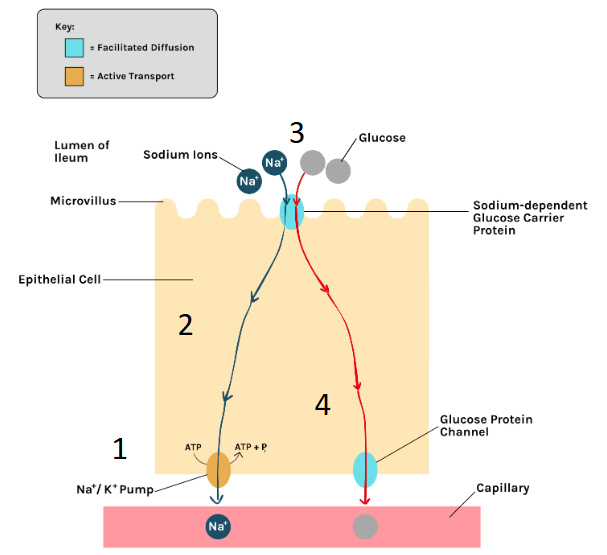digestion and absorption of starch and proteins
1/17
There's no tags or description
Looks like no tags are added yet.
Name | Mastery | Learn | Test | Matching | Spaced |
|---|
No study sessions yet.
18 Terms
what is digestion?
the process in which large insoluble molecules are hydrolysed by enzymes to produce smaller molecules that can be absorbed and assimilated
give and explain 2 examples of mechanical digestion:
larger food molecules broken down into smaller pieces by teeth - allows ingestion and a large SA:V for chemical digestion
food churned by muscles in stomach wall
what does chemical digestion involve?
HCl
bile
digestive enzymes !
what is the duodenum?
first part of the SI
what is the ileum?
last part of the SI
describe the process of starch digestion:
begins in mouth, continues in duodenum, completed in ileum
glycosidic bonds in starch (polysaccharide) hydrolysed by amylase → maltose (disaccharide)
glycosidic bonds in maltose hydrolysed by maltase - membrane bound - → glucose (monosaccharide)
glucose is then absorbed into the blood and taken to cells for respiration OR to be stored as glycogen
what does it mean for disaccharidases to be membrane bound?
positioned on membrane surface of epithelial cells in ileum
give 2 examples of disaccharidases (other than maltase) and where they are produced:
both produced in ileum:
sucrase
lactase
what is sucrase? what does it hydrolyse?
membrane bound disaccharidase
hydroluses sucrose → glucose + fructose
what is lactase? what does it hydrolyse?
membrane bound disaccharidase
hydrolyses lactose → glucose + galactose
where are carbohydrases produced?
salivary glands
pancreas
SI
describe the process of protein digestion:
involves exopeptidases, endopeptidases and membrane-bound dipeptidases
starts in stomach (low pH), continues in duodenum and completed in ileum
peptide bond hydrolysed
AAs released to be used in protein synthesis (for fibrous proteins, enzymes, antibodies, hormones etc.)
what are endopeptidases? give 3 examples:
peptidases that act to hydrolyse peptide bonds w/in a protein, forming multiple peptide fragments
e.g. trypsin, chymotrypsin, pepsin

what are exopeptidases?
peptidases that act to hydrolyse peptide bonds at the end of protein molecules, removing single AAs from proteins and so forming a single peptide fragment and multiple AAs
what are dipeptidases?
type of exopeptidase that works specifically on dipeptides
act to separate the 2 AAs that make up a dipeptide by hydrolysing the peptide bond between them
membrane bound to the cell surface membrane of epithelial cells
where are peptidases produced?
(act in stomach) stomach
(act in duodenum and ileum) pancreas and epithelial cells
describe the absorption of glucose/AAs in the bloodstream:
co transport - how glucose/AAs are absorbed from ileum into bloodstream:
Na+ ions are actively transported out of the epithelial cell into the blood
this lowers the conc of Na+ ions in the epithelial cell, creating a conc gradient of Na+ ions
Na+ and glucose bind to a co-transporter protein and enter cell by facilitated diffusion/co-transport (respectively)
there is now a higher conc of glucose inside the epithelial cell than the blood
glucose moves from cell to blood by facilitated diffusion
(there is no glucose buildup in the blood as the blood flows and carries away absorbed glucose)

how is the surface of the ileum adapted to absorb digested substances?
villi and microvilli - increase SA for absorption
mitochondria - release ATP for active transport
carrier proteins - allow active transport/facilitated diffusion into epithelial cells
network of capillaries and peristalsis of muscles maintain diffusion gradient